2014 CHRYSLER 200 CONVERTIBLE tow
[x] Cancel search: towPage 30 of 522

General Information
This device complies with part 15 of FCC rules and with
RS-210 of Industry Canada. Operation is subject to the
following conditions:
1. This device may not cause harmful interference.
2. This device must accept any interference that may bereceived including interference that may cause unde-
sired operation.
NOTE: Changes or modifications not expressly ap-
proved by the party responsible for compliance could
void the user’s authority to operate the equipment.
If your RKE transmitter fails to operate from a normal
distance, check for these two conditions:
1. Weak battery in the RKE transmitter. The expected life of a battery is five years. 2. Closeness to a radio transmitter such as a radio station
tower, airport transmitter, military base, and some
mobile or CB radios.
REMOTE STARTING SYSTEM — IF EQUIPPED
This system uses the Remote Keyless Entry
(RKE) transmitter to start the engine conve-
niently from outside the vehicle while still
maintaining security. The system has a range of
approximately 66 ft (20 m).
NOTE:
• The vehicle must be equipped with an automatic
transmission to be equipped with Remote Start.
• Obstructions between the vehicle and the Key Fob may
reduce this range.
28 THINGS TO KNOW BEFORE STARTING YOUR VEHICLE
Page 50 of 522
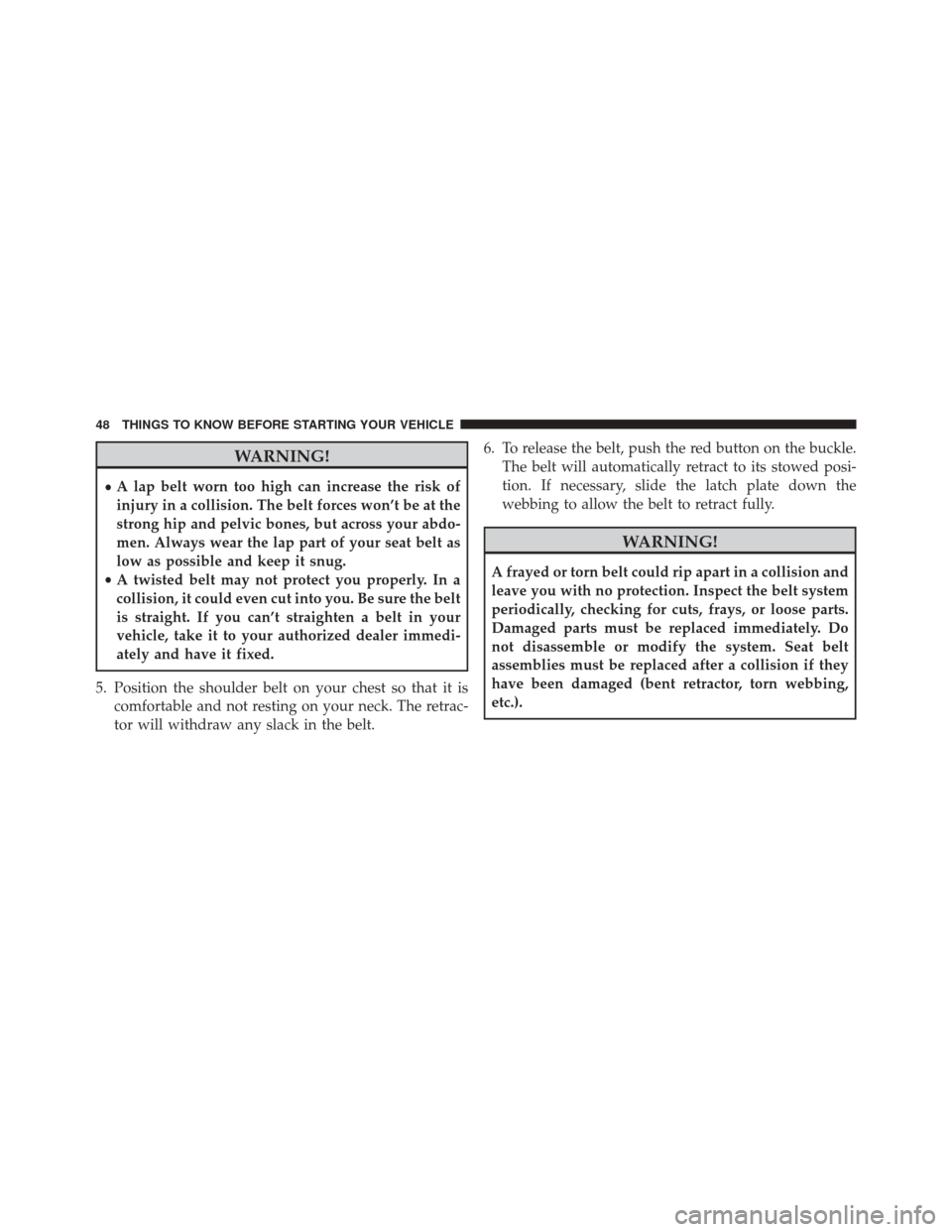
WARNING!
•A lap belt worn too high can increase the risk of
injury in a collision. The belt forces won’t be at the
strong hip and pelvic bones, but across your abdo-
men. Always wear the lap part of your seat belt as
low as possible and keep it snug.
• A twisted belt may not protect you properly. In a
collision, it could even cut into you. Be sure the belt
is straight. If you can’t straighten a belt in your
vehicle, take it to your authorized dealer immedi-
ately and have it fixed.
5. Position the shoulder belt on your chest so that it is comfortable and not resting on your neck. The retrac-
tor will withdraw any slack in the belt. 6. To release the belt, push the red button on the buckle.
The belt will automatically retract to its stowed posi-
tion. If necessary, slide the latch plate down the
webbing to allow the belt to retract fully.
WARNING!
A frayed or torn belt could rip apart in a collision and
leave you with no protection. Inspect the belt system
periodically, checking for cuts, frays, or loose parts.
Damaged parts must be replaced immediately. Do
not disassemble or modify the system. Seat belt
assemblies must be replaced after a collision if they
have been damaged (bent retractor, torn webbing,
etc.).
48 THINGS TO KNOW BEFORE STARTING YOUR VEHICLE
Page 56 of 522

1. Grasp the deployed AHR from the rear seat.
2. Position the hands on the top of the deployed AHR ata comfortable position.
3. Pull downthenrearward towards the rear of the
vehicle then downto engage the locking mechanism.
Hand Positioning Points On AHR
1 — Downward Movement
2 — Rearward Movement
54 THINGS TO KNOW BEFORE STARTING YOUR VEHICLE
Page 58 of 522
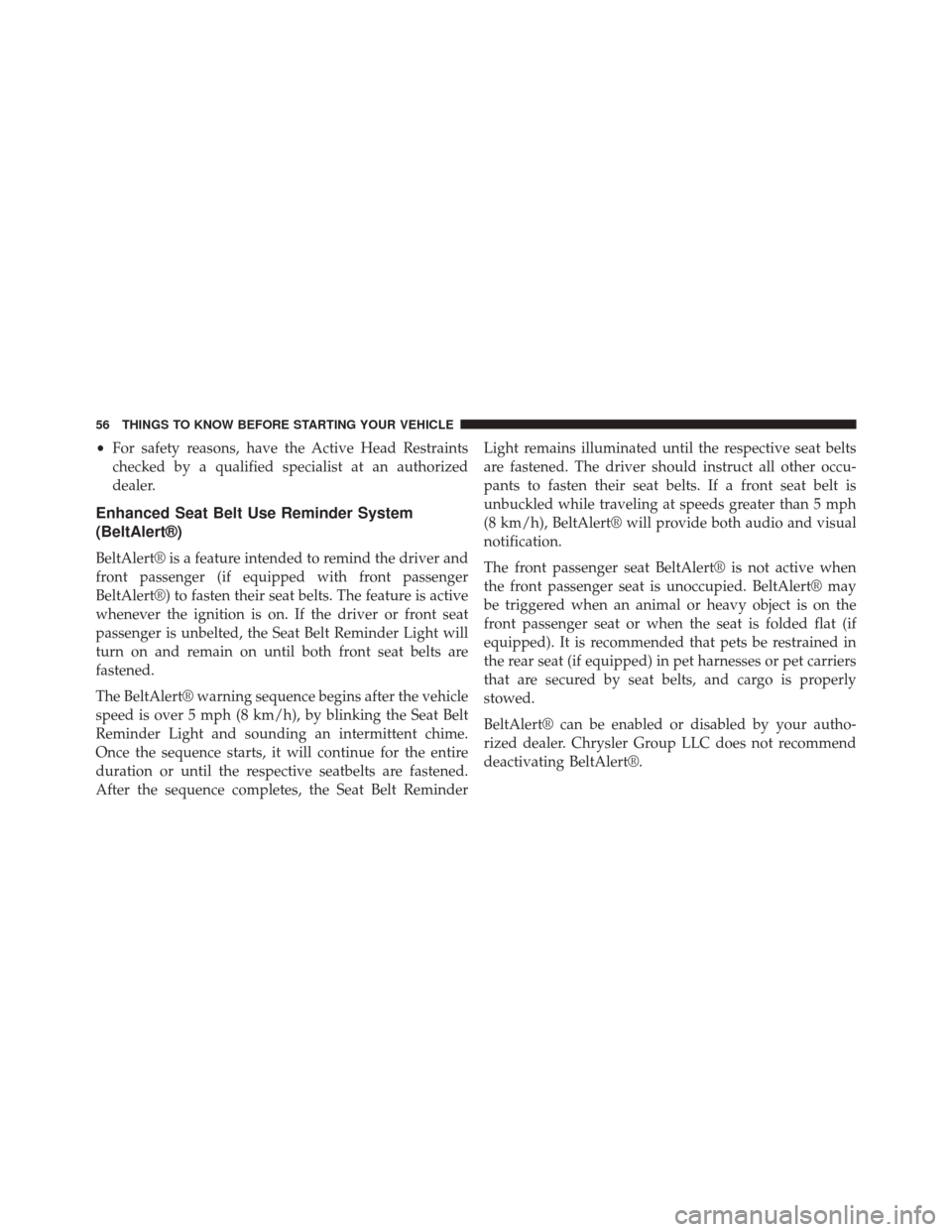
•For safety reasons, have the Active Head Restraints
checked by a qualified specialist at an authorized
dealer.
Enhanced Seat Belt Use Reminder System
(BeltAlert®)
BeltAlert® is a feature intended to remind the driver and
front passenger (if equipped with front passenger
BeltAlert®) to fasten their seat belts. The feature is active
whenever the ignition is on. If the driver or front seat
passenger is unbelted, the Seat Belt Reminder Light will
turn on and remain on until both front seat belts are
fastened.
The BeltAlert® warning sequence begins after the vehicle
speed is over 5 mph (8 km/h), by blinking the Seat Belt
Reminder Light and sounding an intermittent chime.
Once the sequence starts, it will continue for the entire
duration or until the respective seatbelts are fastened.
After the sequence completes, the Seat Belt Reminder Light remains illuminated until the respective seat belts
are fastened. The driver should instruct all other occu-
pants to fasten their seat belts. If a front seat belt is
unbuckled while traveling at speeds greater than 5 mph
(8 km/h), BeltAlert® will provide both audio and visual
notification.
The front passenger seat BeltAlert® is not active when
the front passenger seat is unoccupied. BeltAlert® may
be triggered when an animal or heavy object is on the
front passenger seat or when the seat is folded flat (if
equipped). It is recommended that pets be restrained in
the rear seat (if equipped) in pet harnesses or pet carriers
that are secured by seat belts, and cargo is properly
stowed.
BeltAlert® can be enabled or disabled by your autho-
rized dealer. Chrysler Group LLC does not recommend
deactivating BeltAlert®.
56 THINGS TO KNOW BEFORE STARTING YOUR VEHICLE
Page 84 of 522
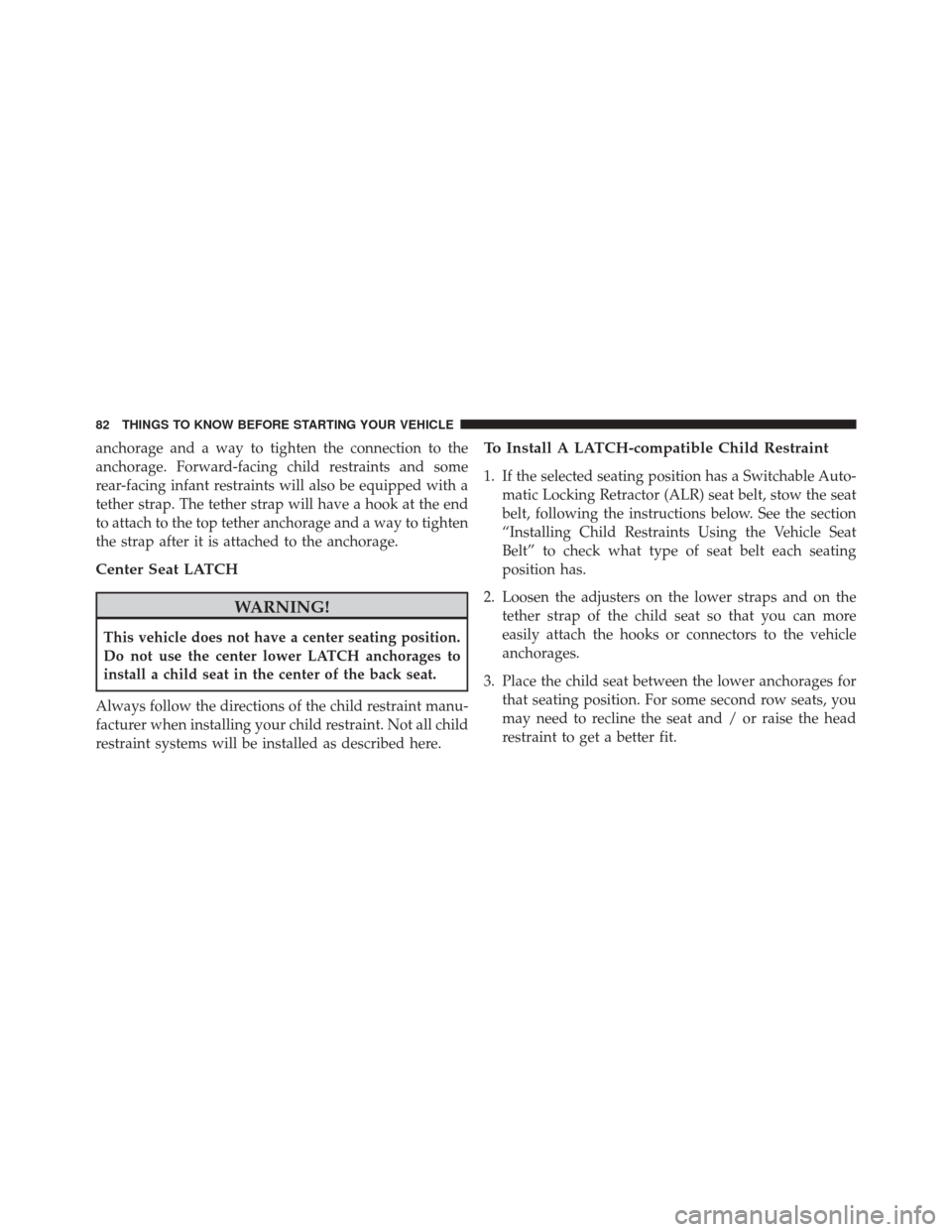
anchorage and a way to tighten the connection to the
anchorage. Forward-facing child restraints and some
rear-facing infant restraints will also be equipped with a
tether strap. The tether strap will have a hook at the end
to attach to the top tether anchorage and a way to tighten
the strap after it is attached to the anchorage.
Center Seat LATCH
WARNING!
This vehicle does not have a center seating position.
Do not use the center lower LATCH anchorages to
install a child seat in the center of the back seat.
Always follow the directions of the child restraint manu-
facturer when installing your child restraint. Not all child
restraint systems will be installed as described here.
To Install A LATCH-compatible Child Restraint
1. If the selected seating position has a Switchable Auto- matic Locking Retractor (ALR) seat belt, stow the seat
belt, following the instructions below. See the section
“Installing Child Restraints Using the Vehicle Seat
Belt” to check what type of seat belt each seating
position has.
2. Loosen the adjusters on the lower straps and on the tether strap of the child seat so that you can more
easily attach the hooks or connectors to the vehicle
anchorages.
3. Place the child seat between the lower anchorages for that seating position. For some second row seats, you
may need to recline the seat and / or raise the head
restraint to get a better fit.
82 THINGS TO KNOW BEFORE STARTING YOUR VEHICLE
Page 85 of 522

4. Attach the lower hooks or connectors of the childrestraint to the lower anchorages in the selected seat-
ing position.
5. If the child restraint has a tether strap, connect it to the top tether anchorage. See the section “Installing Child
Restraints Using the Top Tether Anchorage” for direc-
tions to attach a tether anchor.
6. Tighten all of the straps as you push the child restraint rearward and downward into the seat. Remove slack
in the straps according to the child restraint manufac-
turer ’s instructions.
7. Test that the child restraint is installed tightly by pulling back and forth on the child seat at the belt
path. It should not move more than 1 inch (25.4 mm)
in any direction.How To Stow An Unused ALR Seatbelt
When using the LATCH attaching system to install a
child restraint, stow all ALR seat belts that are not being
used by other occupants or being used to secure child
restraints. An unused belt could injure a child if they play
with it and accidentally lock the seatbelt retractor. Before
installing a child restraint using the LATCH system,
buckle the seat belt behind the child restraint and out of
the child’s reach. If the buckled seat belt interferes with
the child restraint installation, instead of buckling it
behind the child restraint, route the seat belt through the
child restraint belt path and then buckle it. Do not lock
the seatbelt. Remind all children in the vehicle that the
seat belts are not toys and that they should not play with
them.
2
THINGS TO KNOW BEFORE STARTING YOUR VEHICLE 83
Page 104 of 522
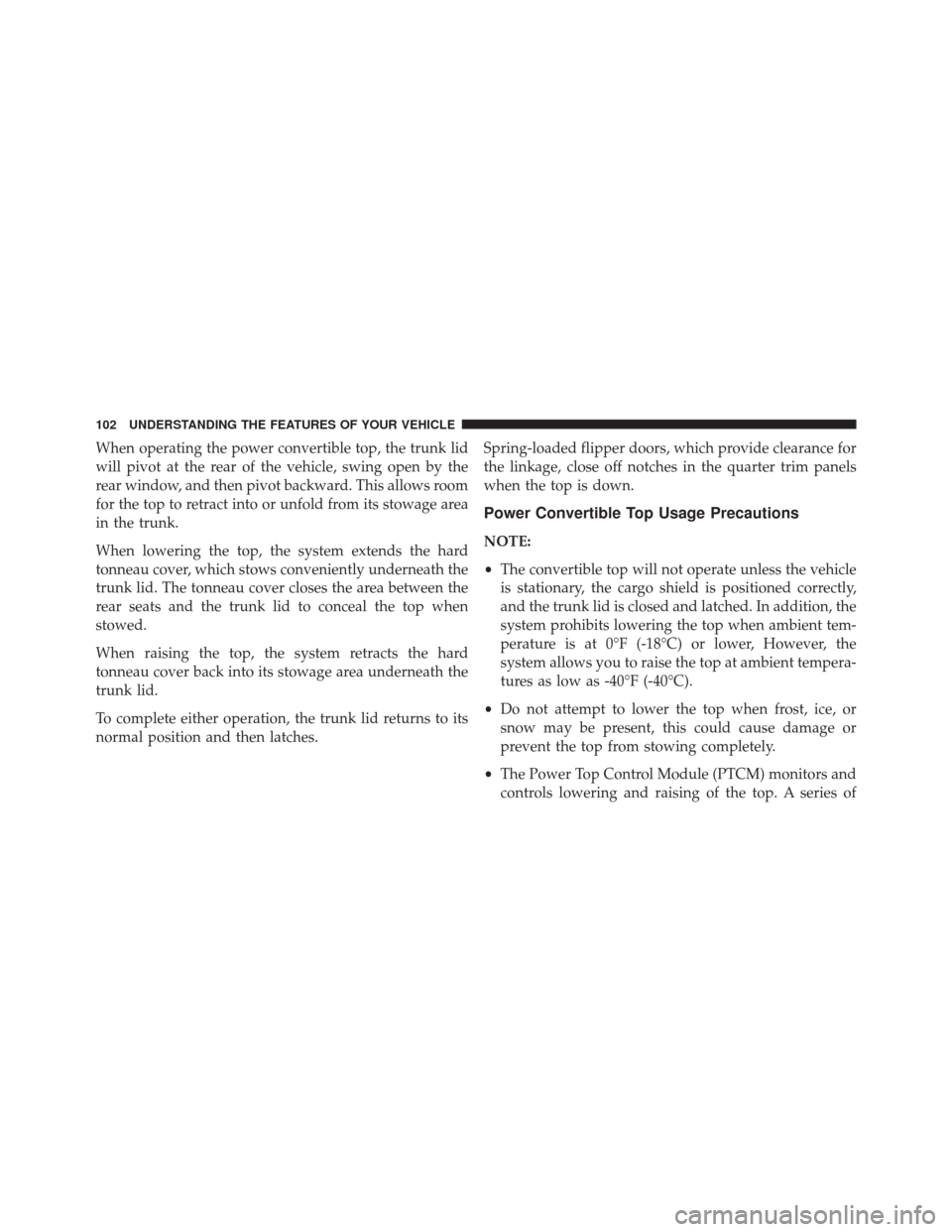
When operating the power convertible top, the trunk lid
will pivot at the rear of the vehicle, swing open by the
rear window, and then pivot backward. This allows room
for the top to retract into or unfold from its stowage area
in the trunk.
When lowering the top, the system extends the hard
tonneau cover, which stows conveniently underneath the
trunk lid. The tonneau cover closes the area between the
rear seats and the trunk lid to conceal the top when
stowed.
When raising the top, the system retracts the hard
tonneau cover back into its stowage area underneath the
trunk lid.
To complete either operation, the trunk lid returns to its
normal position and then latches.Spring-loaded flipper doors, which provide clearance for
the linkage, close off notches in the quarter trim panels
when the top is down.
Power Convertible Top Usage Precautions
NOTE:
•
The convertible top will not operate unless the vehicle
is stationary, the cargo shield is positioned correctly,
and the trunk lid is closed and latched. In addition, the
system prohibits lowering the top when ambient tem-
perature is at 0°F (-18°C) or lower, However, the
system allows you to raise the top at ambient tempera-
tures as low as -40°F (-40°C).
• Do not attempt to lower the top when frost, ice, or
snow may be present, this could cause damage or
prevent the top from stowing completely.
• The Power Top Control Module (PTCM) monitors and
controls lowering and raising of the top. A series of
102 UNDERSTANDING THE FEATURES OF YOUR VEHICLE
Page 105 of 522
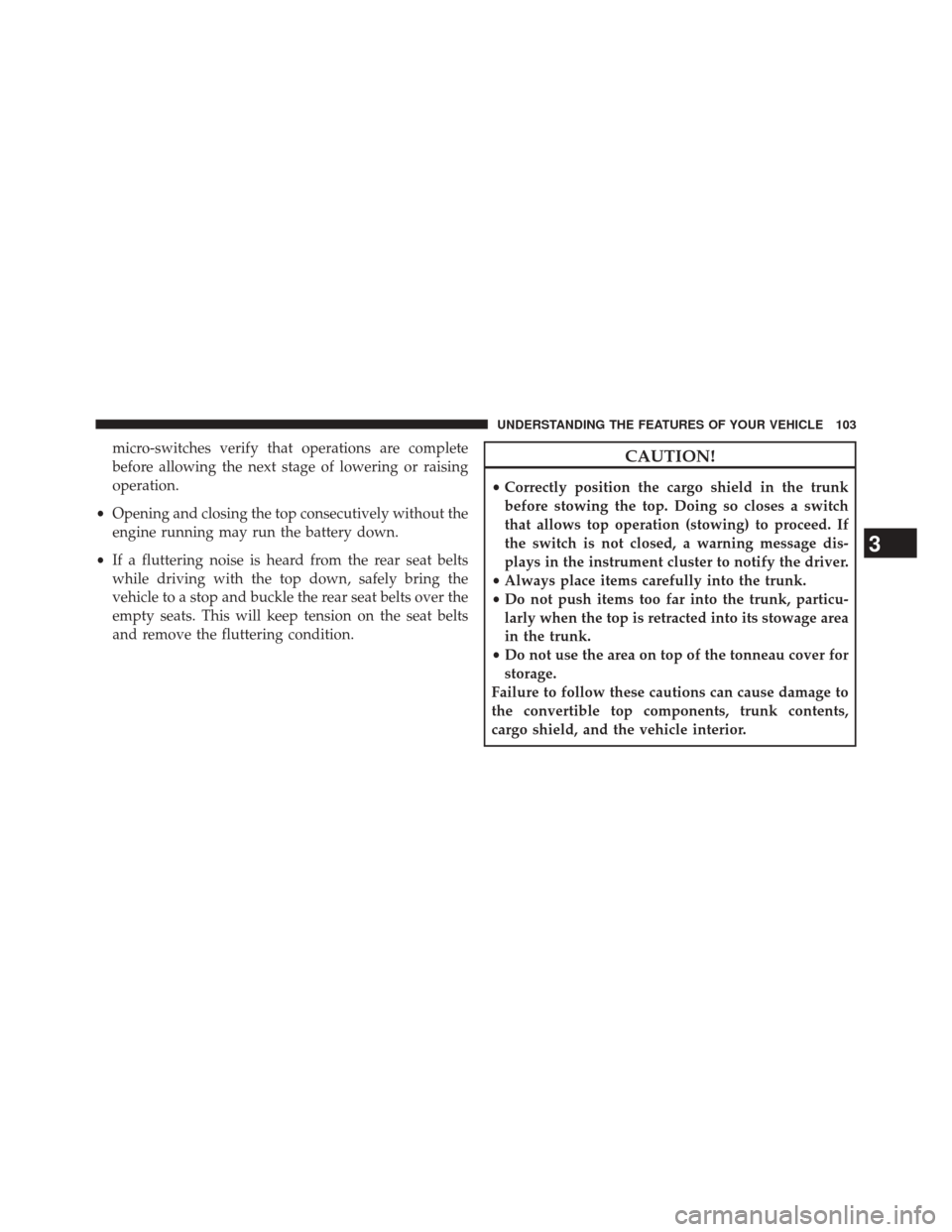
micro-switches verify that operations are complete
before allowing the next stage of lowering or raising
operation.
• Opening and closing the top consecutively without the
engine running may run the battery down.
• If a fluttering noise is heard from the rear seat belts
while driving with the top down, safely bring the
vehicle to a stop and buckle the rear seat belts over the
empty seats. This will keep tension on the seat belts
and remove the fluttering condition.CAUTION!
• Correctly position the cargo shield in the trunk
before stowing the top. Doing so closes a switch
that allows top operation (stowing) to proceed. If
the switch is not closed, a warning message dis-
plays in the instrument cluster to notify the driver.
• Always place items carefully into the trunk.
• Do not push items too far into the trunk, particu-
larly when the top is retracted into its stowage area
in the trunk.
• Do not use the area on top of the tonneau cover for
storage.
Failure to follow these cautions can cause damage to
the convertible top components, trunk contents,
cargo shield, and the vehicle interior.
3
UNDERSTANDING THE FEATURES OF YOUR VEHICLE 103